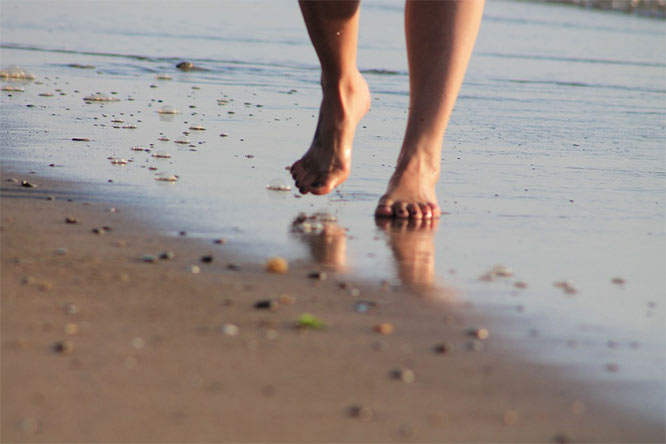
Running barefoot is becoming an increasingly popular option for runners, with many citing the potential benefits of experiencing more excellent balance and better foot alignment while running. But before deciding to run without shoes, knowing what you’re getting yourself into is essential – both pros and cons.
In this blog post, we’ll explore whether or not barefoot running is a suitable choice for all types of runners – from experienced distance athletes to leisurely joggers. So read on if you want to learn more about the pros and cons of ditching those socks!
Pros
1. They Help Maintain a Natural Gait
The human body is designed to run without shoes – that’s why many of us have our toes! Regular running shoes can cause your body to adopt an unnatural gait, leading to potential overuse injuries. Running barefoot helps you maintain a natural stride and posture, reducing the risk of injury and making it easier to achieve your fitness goals.
2. They Strengthen Foot Muscles
Running barefoot forces your feet to work harder because they are not cushioned or supported by a shoe. This increased effort strengthens the muscles in your foot, resulting in more excellent stability and balance as you run. Additionally, running without shoes also helps to improve proprioception – your body’s awareness of its position in space.
3. They Promote Better Running Form
Because there is no cushioning or support from a shoe, running barefoot encourages you to run with a lighter step and better form. This, in turn, reduces the risk of injury and improves overall performance.
The thin soles of barefoot running shoes make it easier to feel the ground and adjust your foot strike accordingly. For example, if your heel strikes the ground too hard, you can adjust to a midfoot or forefoot strike to reduce impact.
4. Reduces Injury Risk
Running barefoot has been found to reduce the risk of injury, likely due to its ability to promote better running form and increased proprioception. Additionally, when running without shoes, you’re less likely to land with too much force since your feet will be more sensitive to changes in terrain.
Injuries like plantar fasciitis, where the fascia tissue in the bottom of your foot becomes inflamed and irritated, may also be decreased with barefoot running.
Cons
1. You’re More Prone to Cuts and Bruises
Unfortunately, running barefoot comes with its own risks – cuts and bruises from sharp objects like rocks, debris, and broken glass. This can be a significant issue for new barefoot runners not used to running without shoes.
You’ll want to be extra mindful of your surface selection when choosing a route, as some surfaces may be more hazardous than others.
2. You Need Time to Acclimate
The transition from running with shoes to barefoot is not easy and requires a significant amount of time to acclimate. You should always start with short distances and build up your mileage as your feet strengthen. This will allow you to avoid injuries and ensure that you’re not overdoing it while running barefoot. It also helps to gradually increase your speed to ensure you’re running smoothly before you’re ready.
3. Not Ideal For Everyone
Barefoot running may not be suitable for all types of runners. For example, those with flat feet or high arches may find it uncomfortable and challenging to run without shoes.
Additionally, if you’re a runner who has suffered from injuries, you should consider consulting with a doctor before switching to barefoot running. People with diabetic neuropathy or foot nerve damage should also avoid running barefoot.
4. It Doesn’t Provide Cushioning
Finally, it’s worth noting that running barefoot does not offer any cushioning or support to your feet. This can disadvantage those looking for extra shock absorption when running on hard surfaces. Additionally, if you’re running in cold weather or on rough terrain, you may need some shoes to protect your feet from cuts and bruises.
Choosing the Right Barefoot Running Shoes
Low Weight and High Flexibility
Barefoot running shoes should be lightweight and flexible to provide your feet with the sensation of running without shoes. This will also help to reduce fatigue as you run and enable you to adjust your footstrike accordingly.
The optimum barefoot running shoe should also have a wide toe box to allow your toes to spread out and flex. You’ll also want to ensure your shoes provide enough grip and traction on different surfaces.
Appropriate Cushioning
While barefoot running shoes must be lightweight and flexible, they should still provide some cushioning for comfort. Look for shoes with cushioning in the heel, midsole, and forefoot to provide the right balance of cushioning and flexibility. The cushioning will depend on your needs, as some runners may need more cushioning than others.
Little-to-No Heel-Toe Drop
Heel-to-toe drop is the height difference between a shoe’s heel and toe. For barefoot running shoes, you’ll want to choose one with little-to-no heel-to-toe drop to provide your feet with a more natural range of motion when running. This can help to reduce fatigue and improve running form and efficiency.
Durable Materials
You want to replace your barefoot running shoes sparingly, so choose a pair with durable materials. Look for shoes made of high-quality materials that can stand up to plenty of miles and won’t wear down too quickly.
Overall, barefoot running is a great way to strengthen your feet and improve your running technique. However, it is crucial to do so correctly to avoid injuries and ensure you’re getting the most out of your runs.


